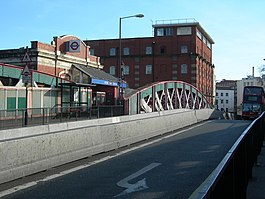
Back رويال أوك (محطة مترو أنفاق لندن) Arabic Royal Oak (stanice metra v Londýně) Czech Royal Oak (London Underground) German ایستگاه متروی رویال اوک Persian Royal Oak (métro de Londres) French 羅夭厄站 GAN Royal Oak metróállomás Hungarian Royal Oak (metropolitana di Londra) Italian როიალ ოუკი (მეტროსადგური) Georgian Royal Oak (metropolitana de Londra) LMO
| Royal Oak | |
|---|---|
 | |
| Location | Westbourne Green |
| Local authority | City of Westminster |
| Managed by | London Underground |
| Number of platforms | 2 |
| Fare zone | 2 |
| London Underground annual entry and exit | |
| 2018 | |
| 2019 | |
| 2020 | |
| 2021 | |
| 2022 | |
| Key dates | |
| 1871 | Opened (GWR & H&C) |
| 1934 | Ended (GWR) |
| 1970 | Transferred to London Transport |
| 2009 | Started (Circle line) |
| Other information | |
| External links | |
| Coordinates | 51°31′09″N 0°11′17″W / 51.519167°N 0.188056°W |
Royal Oak is a station of the London Underground, on the Hammersmith & City and Circle lines, between Westbourne Park and Paddington stations.[6] The station is on Lord Hill's Bridge and is in Travelcard Zone 2 for the London Underground. Although not heavily used at other times, the station is extremely busy during the annual Notting Hill Carnival. There is no wheelchair access to the platform. It is classed as a "local station" in Transport for London's "Fit for the Future" development outline.[7]
The station opened on 30 October 1871,[8] although the Metropolitan Railway extension to Hammersmith had opened in 1864. It is close to the elevated Westway section of the A40 road. The station is named after a nearby public house, "The Royal Oak"[9] (later "The Railway Tap" and now "The Porchester"). There was a small newsagents kiosk next to the ticket office from the 1950s to 1986, when it was closed to make room for ticketing machines needed for the Underground Ticketing System (UTS).[10]
- ^ "Station Usage Data" (CSV). Usage Statistics for London Stations, 2018. Transport for London. 23 September 2020. Archived from the original on 14 January 2023. Retrieved 11 October 2023.
- ^ "Station Usage Data" (XLSX). Usage Statistics for London Stations, 2019. Transport for London. 23 September 2020. Archived from the original on 9 November 2020. Retrieved 9 November 2020.
- ^ "Station Usage Data" (XLSX). Usage Statistics for London Stations, 2020. Transport for London. 16 April 2021. Retrieved 1 January 2022.
- ^ "Station Usage Data" (XLSX). Usage Statistics for London Stations, 2021. Transport for London. 12 July 2022. Retrieved 7 September 2022.
- ^ "Station Usage Data" (XLSX). Usage Statistics for London Stations, 2022. Transport for London. 4 October 2023. Retrieved 10 October 2023.
- ^ Baker 2007, p. 21, section B1
- ^ "Fit for the Future: Future Stations". Transport for London. Retrieved 13 May 2015.
- ^ Butt 1995, p. 200
- ^ Harris 2006, p. 60
- ^ TFL Corporate Archives ref. LT000726/045
